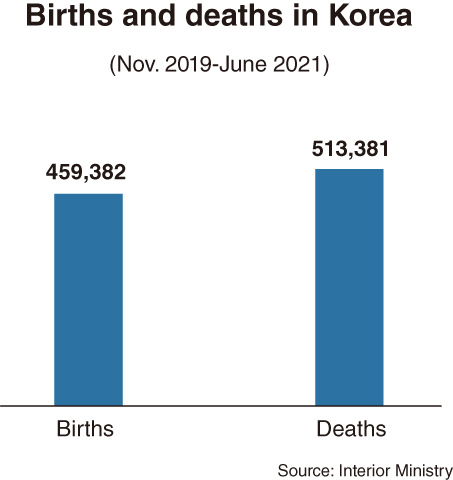[News Focus] Deaths outnumber births by 53,000 since late 2019
In Korea, deaths tally outstrips births tally in 19 of 20 months
By Kim Yon-sePublished : July 27, 2021 - 16:30

SEJONG -- The number of births was outpacing deaths by 100 percent in South Korea a decade ago, with their monthly tallies recording nearly 40,000 vs. 20,000 throughout 2011.
The gap between the two sharply narrowed in the early 2010s in the wake of record-low fertility rates, under which the number of births was only higher -- by about 50 percent -- than that of deaths in 2016.
A historic event occurred in January 2018, when deaths outnumbered births by 31,857 vs. 30,615. This marked the first time, unofficially, that the numbers switched since the 1960s.
The second and third major “deaths outnumbering births” events in monthly statistics were seen in December 2018 (24,854 deaths vs. 24,761) and January 2019 (28,684 deaths vs. 28,155). Nonetheless, births still commonly outnumbered deaths in 2018 and 2019, except for the three months over the 24-month period.
The era of “arithmetical” population decline eventually started in November 2019, while the demographic figure also reflects the number of foreign nationals in the nation -- based on their resident registration -- and Koreans residing overseas as well as citizenship changes of Koreans and foreigners.

Of the 20 months from November 2019-June 2021, the number of deaths outstripped that of births for 19 months, except for only once in September 2020.
The cumulative deaths tally was higher by about 11.7 percent (53,999) than that of births for the 20-month period by 513,381 vs. 459,382.
Last month, the gap widened as the number of deaths was higher by 13.9 percent than that of births by 25,089 vs. 22,012.
In this situation, the demographic structure represents the seriousness -- the number of people under 10 (3.85 million) posted less than 50 percent of the tallies for those in their 40s (8.21 million) and those in their 50s (8.59 million) as of June.
The tally for youngest age bracket also stood at less than 60 percent of the number of those in their 60s (7 million) or those in their 30s (6.77 million). Further, the number of children aged 0-9 were also comparable to the tally for those aged 70-79 (3.69 million).
According to data from the Organization for Economic Cooperation and Development, South Korea far fell behind the average of its 37 members and some nonmembers in fertility rates, with the country already having been ranked at the bottom in the world.
In 2019, Korea posted a 0.92 fertility rate -- the total number of children that would be born to each woman if she were to live to the end of her child-bearing years.
Of the 37 members, six have publicized the 2019 figures: 1.83 in France, 1.72 in New Zealand, 1.7 in Denmark, 1.7 in Sweden and 1.53 in Norway. The average of OECD reached 1.61 in the corresponding year.
Among nonmembers, South Africa recorded 2.4, Argentina at 2.25, Indonesia at 2.29, Peru at 2.23, Saudi Arabia at 2.28, India at 2.2, Romania at 1.77, Brazil at 1.72, China at 1.7 and Russia at 1.5.
Since last year, Korea’s fertility rate has stayed under the 0.9-mark to post 0.84 in June 2020 and 0.88 in March 2021.
The low fertility rates and a longer life span has brought about the all-time high average age of Koreans at 43.4 (42.3 for men and 44.6 for women) as of June.
By Kim Yon-se (kys@heraldcorp.com)



![[Exclusive] Korean military set to ban iPhones over 'security' concerns](http://res.heraldm.com/phpwas/restmb_idxmake.php?idx=644&simg=/content/image/2024/04/23/20240423050599_0.jpg&u=20240423183955)

![[Graphic News] 77% of young Koreans still financially dependent](http://res.heraldm.com/phpwas/restmb_idxmake.php?idx=644&simg=/content/image/2024/04/22/20240422050762_0.gif&u=)



![[Pressure points] Leggings in public: Fashion statement or social faux pas?](http://res.heraldm.com/phpwas/restmb_idxmake.php?idx=644&simg=/content/image/2024/04/23/20240423050669_0.jpg&u=)









